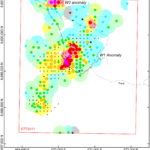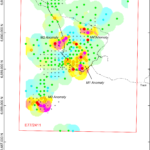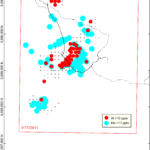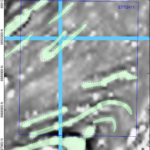Karroun Project
Tim Fairhead
2023-09-15T11:01:13+08:00
Karroun Project
- A multi-metal exploration project in an area where there has been no detailed previous exploration.
- The target metals are tungsten, molybdenum, nickel and gold.
- Meridian 120 owns 100% of a granted exploration licence of 12 square kilometres. The tenement is in good standing, with an expiry date of 3 May 2027 (and the possibility of extension).
Geology
- Bedrock in the licence is mostly (95%) concealed by regolith cover. There is only about 1% fresh bedrock and about 4% deeply weathered saprolite bedrock.
- The rare fresh outcrops are Archean gneiss, granite and pegmatite, but aeromagnetics and geochemistry (high chromium, vanadium etc) suggest that greenstone strata including ultramafics are probably present beneath much of the large area covered by soil and sand.
Tungsten
- Laterite geochemical sampling defines two large tungsten anomalies (up to 900 metres long by 300 metres wide) with peak value 34 ppm W against a background of 1 ppm).
- Tungsten is a crucial rare metal used in the aerospace, defence, engineering, metallurgical, electronics and construction industries.
- It is a designated critical mineral in Australia, the USA, the European Union and Britain.
Molybdenum
- There are four large molybdenum laterite anomalies (up to 700 by 400 metres) with peak value 36 ppm Mo against a background of about 1 to 3 ppm.
Bismuth
- All samples collected across the entire licence show very strongly anomalous bismuth (peak value 10 ppm against a background of about 0.5ppm or less).
- Bismuth is a rare metal typically associated with strong hydrothermal activity.
- It is often a pathfinder element for mineral deposits including gold deposits, VMS copper-zinc- deposits, tungsten skarn deposits and quartz vein molybdenum deposits.
Metal Zoning
- The geochemical pattern suggests that several molybdenum anomalies may form a ring around the biggest tungsten anomaly. The high bismuth results also define a loop.
- This may be concentric metal zoning around a central hydrothermal fluid source (probably a highly fractionated granite intrusion?).
Likely Mineralisation (beneath the anomalies)
- The characteristics of the anomalies (the tungsten-molybdenum-bismuth association, the large size of the anomalies, the presence of concentric metal zoning and evidence of fractionated granite nearby) suggest the presence of porphyry tungsten-molybdenum mineralisation beneath the surface.
- Porphyry tungsten-molybdenum deposits are a well known and well documented style of mineral deposit. They occur in countries around the world and in rocks of many ages.
- They are typically very large (100 million tonnes to 1 billion tonnes).
- Examples of this style include: Sisson Brook (USA), Mount Pleasant (Canada), Northern Dancer (Canada), Xingluokeng (China), Myszkow (Poland), Pervomaisky (Russia) and Spinifex Ridge (Australia).
Nickel Potential
- Recent drilling by Nimy Resources encountered thick ultramafic and mafic strata along strike from Karroun. Their ASX announcements (13 April 2022, 29 April 2022, 26 July 2022) record visual and pXRF detection of nickel and copper sulphides at Godley Prospect, 15 kilometres south- west of Karroun) and Dease Prospect, only 10 kilometres south-west of Karroun.
Exploration Potential
- Less than half of the licence has been sampled to date – each visit is revealing new anomalies and enlarging known ones.
- Extensive soil covered areas remain untested.
- We have not yet drilled the tungsten-molybdenum target area beneath the laterite anomalies.
- We have not yet commenced nickel and gold exploration.
Opportunity
- The project is available for option, purchase or joint venture.







